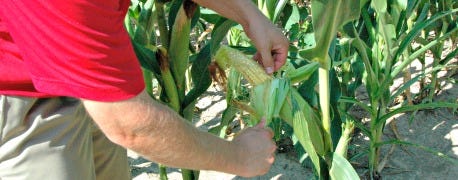July 27, 2014

There are so many factors in executing an efficient and profitable corn silage harvest that it pays to get an early start on preparation. From field monitoring to equipment management and inoculants selection, producers need to get the jump on corn silage harvest to manage all aspects for success.
1. Estimate silking dates. It’s prime time to estimate when fields will be ready based on tassel or silk dates. Silk dates (R1) occur when corn plants are at maximum or near-maximum height and have maximum vegetative dry matter. Most hybrids require 55 to 60 days to reach physiological maturity after silking, so it can serve as a good planning benchmark.

MONITOR CROP: Farmers should be assessing their corn crop to determine the best time for silage harvest.
2. Monitor moisture levels. Achieving proper moisture, the most important factor in making high-quality corn silage, is dependent on the silo structure used and the processing of the crop. Three ways to determining proper harvest moisture are:
Tassel date. Research shows that grain should be in half-milk line stage 40 to 45 days from tassel date; however, advancing maturity depends on the growing environment.
Milk line. At 30 to 40 days post-tassel, walk the field and select ears to determine the milk line. At that point, moisture should be around 72 percent.
Sample silage. Chop some forage and use a microwave or moisture tester to determine the actual dry matter and moisture content.
3. Prepare equipment. Properly prepared and adjusted corn silage harvest equipment can help prevent fermentation and nutritional issues. Get the shear bar set for the right length of cut, use a kernel processor or a shredlage processor with good roll clearance and plan to check the loads early and often. Make sure silos are in good repair to avoid leaks.
4. Select inoculant. One of the most critical steps in preparing for a successful corn silage harvest is choosing a silage inoculant. Pioneer offers leading-edge inoculants to help prevent loss from shrink and help silage remain stable at feedout.
5. Revisit safety training. Now is a great time to sit down with employees and family members to talk about potential threats and revisit safety training. Equipment should also be given all safety checks, and fields and roads should be inspected to avoid hazards. Any needed personal safety equipment can be ordered so it’s on hand for harvest on the day it begins.
Getting a head start on preparation can help producers get the highest volume of the best quality corn silage out of the field at the right time, and with fewer delays.
Source: Pioneer
You May Also Like




